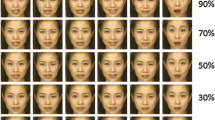Abstract.
Autism is a pervasive developmental disorder (PDD) characterized by the association of communication and socialization impairments, and by repetitive stereotyped behaviours. The Minnesota Test of Affective Processing (MNTAP) was used to investigate the discrimination of face identities and face expressions by autistic children. Young children in the 6- to 10-year-old age range suffering from PDD were compared to paired normal children. When the expressions on faces remained neutral, autistic patients had more difficulty in distinguishing different faces than in matching the same facial identities in face pairs: they perceived different faces as being identical. However, recognition errors disappeared when expressions were changed together with face identity. When autistic children were asked to distinguish expressions, they discriminated better identity than difference, just as normal children do. Analysis of face and expression discrimination in terms of identity and difference is a novel approach for the understanding of the clinical features of autism. Autistic children seek sameness and use an atypical strategy to analyse human faces and expressions.
Similar content being viewed by others
References
Baron-Cohen S (1989) The autistic child’s theory of mind: a case of specific developmental delay. J Child Psychol Psychiatry & Allied Disciplines 30:285–297
Baron-Cohen S (1991) The development of a theory of mind in autism: deviance and delay? Psychiatr Clin N Am 14:33–51
Baron-Cohen S, Leslie AM, Frith U (1985) Does the autistic child have a “theory of mind”? Cognition 21:37–46
Bobes MA, Martin M, Olivares E, Valdés-Sosa M (2000) Different scalp topography of brain potentials related to expression and identity matching of faces. Cognitive Brain Res 9:249–260
Boucher J, Lewis V (1992) Unfamiliar facial identity recognition in relatively able autistic children. J Child Psychol Psychiatry 33:843–859
Braverman M, Fein D, Lucci D, Waterhouse L (1989) Affect comprehension in children with pervasive developmental disorders. J Autism Devel Disord 19:301–316
Brun P, Mattlinger M, Nadel J (1998) L’hypothèse émotionnelle dans l’autisme. Psychologie Française 43:147–156:107–121
Celani G, Battacchi MW, Arcidiacono L (1999) The understanding of the emotional meaning of facial expressions in people with autism. J Autism Devel Disord 29:57–66
Davies S, Bishop D, Manstea AS, Tantam D (1994) Face perception in children with autism and Asperger’s syndrome. J Child Psychol Psychiatry 35:1033–1057
De Haan, M, Nelson A (1998) Discrimination and categorisation of facial expressions of emotion during infancy. In: Press P (ed) Taylor and Francis Group, pp 287–309
Hobson RP (1986a) The autistic child’s appraisal of expressions of emotion. J Child Psychol Psychiatry 27:321–342
Hobson RP (1986b) The autistic child’s appraisal of expressions of emotion: a further study. J Child Psychol Psychiatry 27:671–680
Hobson RP, Ouston J, Lee A (1988a) Emotion recognition in autism: coordinating faces and voices. Psychol Med 18:911–923
Hobson RP, Ouston J, Lee A (1988b) What’s in a face? The case of autism. Br J Psychol 79(Pt4):441–453
Jennings WB (1973) A study of the preference for affective cues in autistic children, Memphis State University
Klin A, Sparrow SS, de Bildt A, Cicchetti DV, Cohen DJ, Volkmar FR (1999) A normed study of facial identity recognition in autism and related disorders. J Autism Devel Disord 29:499–508
Langdell (1978) Recognition of faces: an approach to the study of autism. J Child Psychol Psychiatry 19:255–268
Lord C, Rutter M, Le Couteur A (1994) Autism Diagnostic Interview-Revised: a revised version of a diagnostic interview for caregivers of individuals with possible pervasive developmental disorders. J Autism Devel Disord 24:659–685
Miyashita M (1988) Discrimination of facial components in autistic children. Jap J Psychol 59:206–212
Ozonoff S, Pennington BF, Rogers SJ (1990) Are there emotion perception deficits in young autistic children? J Child Psychol Psychiatry 31:343–361
Ozonoff D, Strayer L, McMahon WM, Filloux F (1994) Executive function abilities in autism and Tourette syndrome: an information processing approach. J Child Psychol Psychiatry 35:1015–1032
Pelphrey KA, Sasson NJ, Reznick JS, Paul G, Goldman BD, Piven J (2002) Visual scanning of faces in autism. J Autism Devel Disord 32(4):249–261
Schultz RT, Gauthier I, Klin A, Fulbright RK, Anderson, AW, Volkmar F, Skudlarski FP, Lacadie C, Cohen DJ, Gore JC (2000) Abnormal ventral temporal cortical activity during face discrimination among individuals with autism and Asperger syndrome. Arch Gen Psychiatry 57:331–340
Shapiro EG, Hugues JG, August GJ, Bloomquist ML (1993) Processing of Emotional Information in Children with Attention-Deficit Hyperactivity Disorder. Devel Neuropsychol 9:207–224
Tantam D, Monaghan L, Nicholson H, Stirling J (1989) Autistic children’s ability to interpret faces: a research note. J Child Psychol Psychiatry 30:623–630
Weeks SJ, Hobson RP (1987) The salience of facial expression for autistic children. J Child Psychol Psychiatry 28:137–151
Author information
Authors and Affiliations
Corresponding author
Rights and permissions
About this article
Cite this article
Robel, L., Ennouri, K., Piana, H. et al. Discrimination of face identities and expressions in children with autism: Same or different?. European Child & Adolescent Psychiatry 13, 227–233 (2004). https://doi.org/10.1007/s00787-004-0409-8
Accepted:
Issue Date:
DOI: https://doi.org/10.1007/s00787-004-0409-8




